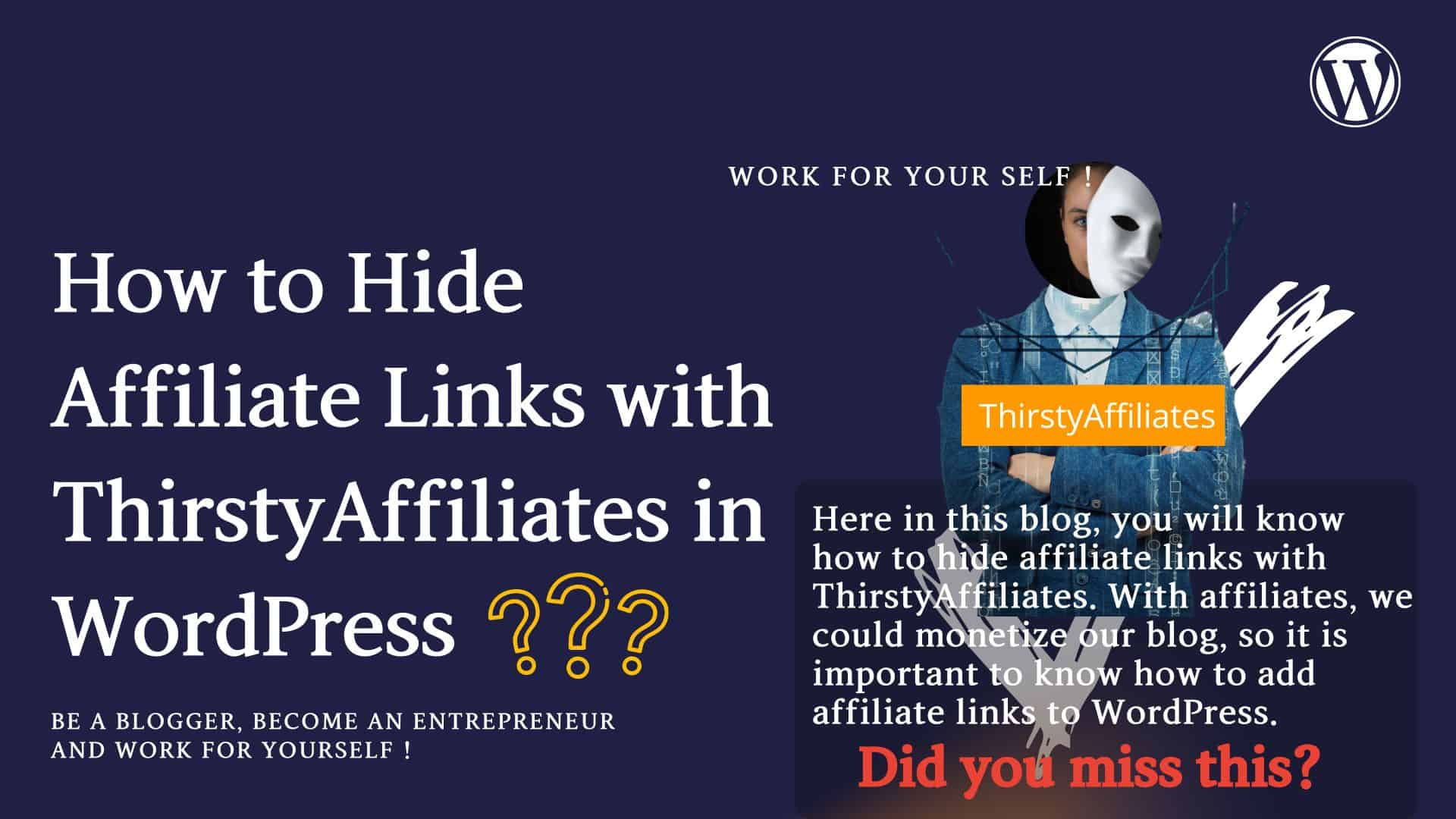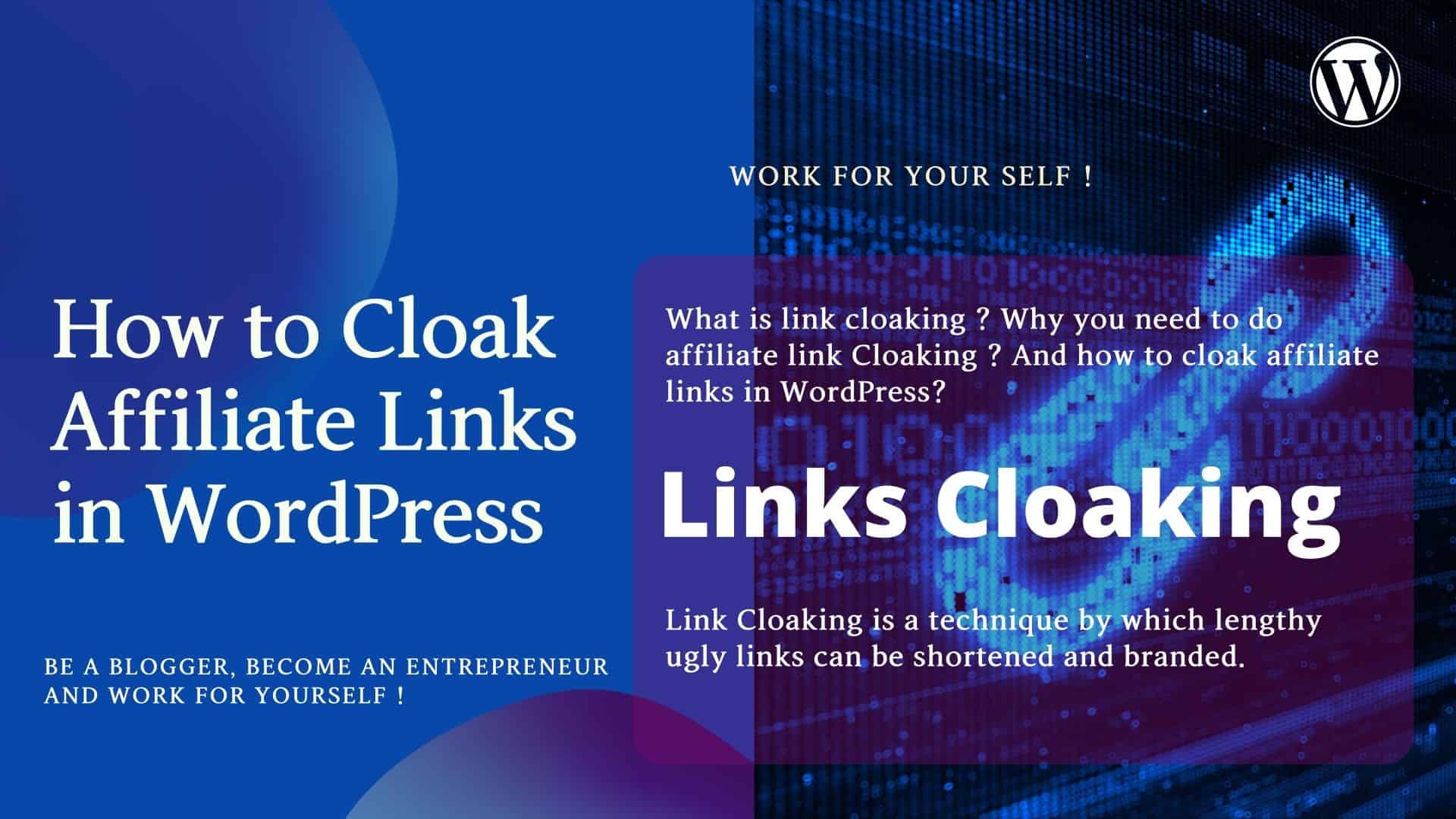We bloggers all want to monetize our blogs. Sometimes, we face problems with monetization. However, affiliate links are the best source for monetizing our websites. Let’s see how to promote affiliate links to gain maximum benefits.
Affiliate marketing is an excellent way to monetize your blog, website, or social media channels.
You can earn commissions for each sale or action generated through your referral by promoting affiliate links.
Without promotion, no one would know what we are offering and recommending.
Indeed, giving equal weight to promotion and content quality is essential.
To maximize your earnings, it’s essential to implement effective strategies for promoting these links.
In this blog, I will cover the promotional strategies you can quickly adopt or replicate to promote your affiliate link.
Table of Contents
ToggleWhat are Affiliate Links?
Affiliate links are the product links that bloggers recommend to their readers.
When readers go with the recommendation and purchase from the link (which the blogger has put in their blog and videos), bloggers get a commission from it without any extra cost to their readers.
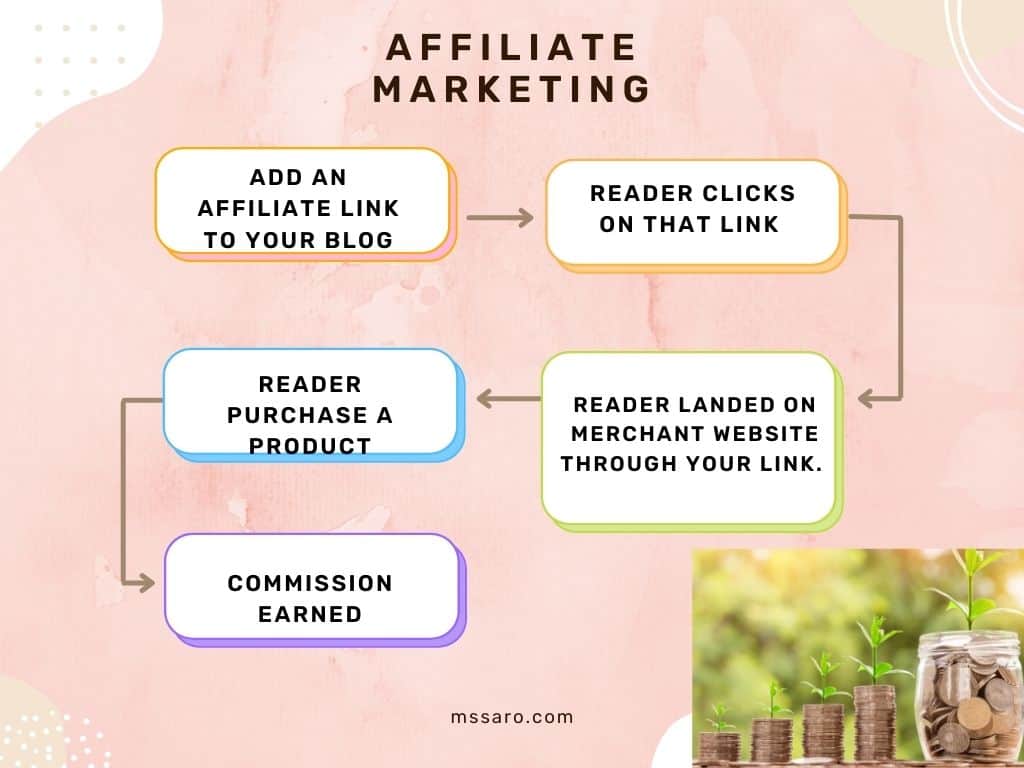
From Where to Get Affiliate Links?
You can get the affiliate link directly from the product website or other networking sites.
- ShareAsale,
- Commission Junction,
- Impact, etc.
How do Affiliate Links Look?
Affiliate links are long URLs that are generally difficult to remember and ugly-looking.
You can easily shorten these links with the help of link-cloaking plugins like ThirstyAffiliate, Pretty Links, URL Shorten Pro, etc.
So, in most cases, you should cloak these affiliate links for your social media promotion.
You cannot cloak the affiliate link in some affiliate programs like Amazon.
Best Places to Promote Affiliate Link
As an affiliate marketer, effectively promoting your affiliate links is crucial for maximizing your earnings.
Choosing the right platforms to reach your target audience can significantly impact your affiliate marketing success.
1. Use a Website to Share Affiliate Link
Having your own website or blog is an excellent platform for promoting affiliate links.
It gives you full control over the content, design, and monetization strategies.
Create valuable and informative content related to your niche and seamlessly integrate your affiliate links into blog posts, product reviews, or resource pages.
With a website or blog, you can build a loyal readership and establish yourself as an authority in your niche.
So, if you own a website, it is the best place to promote an affiliate link.
You must place an affiliate link in a blog post where you have written about the product you want to recommend.
For example, I recommend Bluehost for domain hosting to my readers as I am a satisfied Bluehost customer.
I have placed a Bluehost affiliate link in my blog.
Whenever a reader purchases Bluehost from my link, I will receive a small commission without any extra cost to my readers.
You can refer to our guide for promoting the web hosting affiliate program.
2. Use YouTube to Share Affiliate link
YouTube is a powerhouse platform with billions of monthly users, making it an excellent platform for promoting affiliate links.
With engaging video content, you can leverage the trust and influence you build with your audience to drive conversions and boost your affiliate marketing earnings.
YouTube videos are the second-best way to put your affiliate link.
Though you can not directly place affiliate links in YouTube videos, there are still many options where you can put your affiliate link like video descriptions, YouTube Cards, about and community sections, and pinning the links in the comment section of YouTube videos.
Remember to place a cloaked affiliate link on YouTube. It is an excellent way to enhance your traffic and earnings.
3. Promote Affiliate link on Pinterest
Pinterest is a virtual media platform where you can easily promote affiliate links directly by pinning them on Pinterest pins.
Secondly, you can indirectly promote the affiliate link on Pinterest by promoting your landing page and advertising your website through your blogs.
So that whenever readers get through your Pinterest pins and are redirected toward your website, they will see the product affiliate link in your blog.
Link cloaking is not allowed on Pinterest, and for better results, landing pages should be placed for affiliate link promotion.
4. Use Instagram to Promote Affiliate link
It is a photo and video-sharing social networking site.
Though affiliate links cannot be directly placed on Instagram, they can easily be placed on Instagram stories and bios.
Bio is the place where clickable links are allowed on Instagram.
You can make a link tree, i.e., a micro landing page for your website, and put the same in your Instagram bio.
On Instagram, you can place an affiliate link in two ways
- Profile Bio
- Instagram stories- swipe-up feature (requirement 10k followers for a swipe-up feature activation)
5. Use LinkedIn to Promote Affiliate Links
LinkedIn is also one of the essential social media platforms for promoting a product.
You can quickly add an affiliate link on LinkedIn and reach your target audience.
You can post your blogs on the LinkedIn pulse page directly and monetize your blog through posting affiliate links.
For LinkedIn pulse:
a. Must have a LinkedIn account
b. Click on the write article button, as shown in the below screenshot.

c. Add text, images, and videos and publish them to your audience or followers.
d. After publishing it on the LinkedIn pulse, you can see the same on your LinkedIn profile, and it will also be seen in the feed of your connected people.
The LinkedIn pulse will help to enhance engagement and boost your credibility.
6. Use Facebook to Promote Affiliate link
However, direct affiliate links are not allowed to be promoted here.
But you can show them on your Facebook business or your own profile page.
It is better to have a landing page for your affiliate promotion and drive traffic on Facebook.
7. Use Twitter to Share Affiliate Links
You can place product affiliates in your tweet’s profile description and comment section.
8. Use Quora to Share Affiliate link
Quora, the Q & A (Question & Answer) site, is excellent if you offer your readers relevant information and services.
The best part is adding clickable links while answering the questions.
However, directly placing affiliate links is not allowed in Quora.
You can add the blog links where you have placed the affiliate link, and when readers click your blog, they will see the affiliate link.
Where to Put an Affiliate Link in Your Website/ WordPress Blog?
- Resource Page- Especially page design for affiliate recommendation.
- Blog Post—A blog post is the best place to post a product affiliate link. Some blog post types are comparison blogs, listicles, and informational blogs. Here, you can quickly post your affiliate link. Remember to be as genuine as possible.
- Banners- A specially designed banner could effectively place your affiliate link. Make banners for affiliate links only when you are getting traffic, and your site earned some authority. You can add banners (in the sidebar) to your website. Readers can go from your banner and purchase a product from your affiliate.
- Blog Post Comments- This is also an excellent way to promote an affiliate link when your reader asks something, and while explaining, you can show and request them to purchase from your affiliate link if they are pleased with your answer.
- Buttons– You can create a button for the call to action, such as Click here, Download, Sign-up, Get Started, etc.
- Linking to pictures: Add pictures and embed an affiliate link in each one. Whenever readers click on the pictures, they are directed toward your affiliate link page.
- Landing Pages– Make and promote a landing page on all social media platforms. By doing so, you would get a list of email subscribers and can promote your affiliate link.
- Creating and Promoting E-Books—Always give your readers freebies, such as eBooks, cheat books, and free PDFs; add your product affiliate links so that your readers click on them and purchase from you.
How to Get Traffic to Your Affiliate Links
You may get traffic to your affiliate link in the following ways:
1. Write Blog
Write blogs surrounding your affiliate product.
Suppose you want to promote Bluehost as a hosting, so you must have to write a blog like:
b. Bluehost Guide for a Beginner
c. Write some hosting comparison blog like Comparison between Bluehost, DreamHost, and SiteGround
And so on. In all these blogs, you can add your affiliate link
Remember, while recommending any product to your reader, be genuine.
2. Email Marketing
This is one of the best ways to get traffic to your affiliate links.
With the list of email subscribers, you can directly approach them for your affiliates.
a. Send a welcome email to your subscribers by citing what they will get, as they are your valued customers.
b. First mail might be of your high-traffic blog where you have placed your affiliate links, As there is a high probability that readers will open that mail as they have just subscribed to you.
c. Whenever you mail your reader, your signature will also go with that.
Add those blog links where you have placed an affiliate link at your signature, or you can add tree links.
So that whenever readers receive any mail from your blog, they will receive all the link information too.
d. Select your targeted audience; it is not cold calling and spamming your reader inbox but targeting some genuine readers, even those less than 10, and email them about your product and services.
Refer to our blog, Email Marketing Best Practices, for more insight.
3. Resources and Tools page
Make an option for a resource page on your website.
All your affiliate links blogs would be listed on this page, and the reader could see what you are recommending directly.
List the tools or plugins you are using. Your resource and tool page should list all the tools you use or recommend to your readers.
4. YouTube
YouTube is one of the best places to show your affiliate link.
Though you cannot directly place affiliate links, there are options like the YouTube description, Comment section (by pinning it), Community tab, and About tab where you can place them.
How to Put an Affiliate Link in WordPress Website
You can quickly put an affiliate link in WordPress:
Put Affiliate link Manually
This is the easiest way to use an affiliate link in WordPress.
Copy and paste the affiliate link to your desired place in your blog post.
You can place affiliate links using a specific word or easily create a button.
Suppose I want to recommend Bluehost to my readers, and I got a Bluehost Affiliate link by joining its affiliate program.
For more about how to join the Bluehost Affiliate Program, refer to our video
Suppose I want to add an affiliate link to word Bluehost; copy and paste the affiliate URL into WordPress.
Make sure to click open in the new tab
Remember to mark it as a no-follow link.
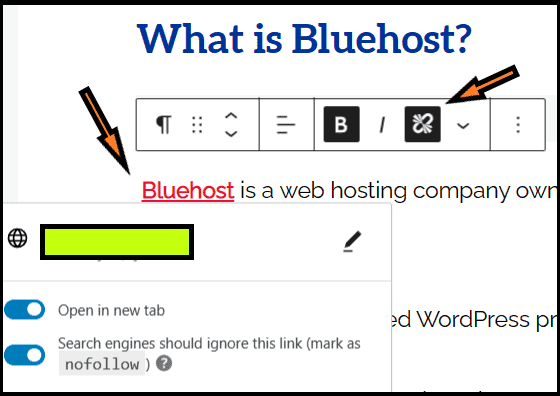
Plugins:
Plugins like Thirsty Affiliate, Pretty Links, Easy Affiliate Links, and many more make it easy to place your affiliate link.
If you have many affiliate links, it’s better to have plugins to assist you and manage your affiliate links.
I have Thirsty affiliate link plugins that quickly shorten long URLs and make them pretty good to remember.
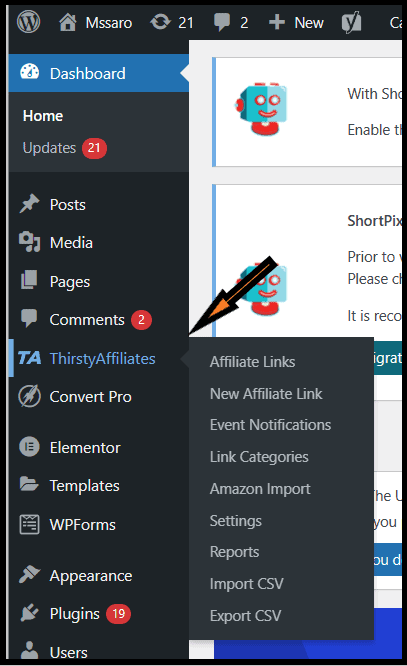
At Add title– write the product name (which you are recommending to your readers)
Destination URL: Add original Affiliate link
You can add an image of the product if you want; it is not mandatory.
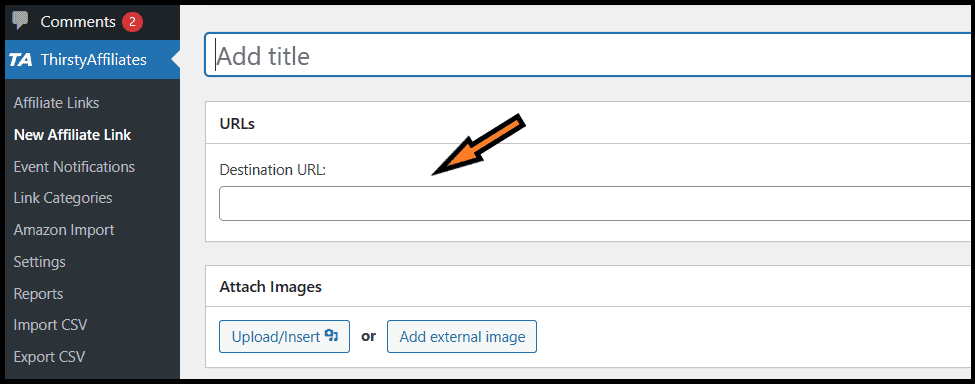
The cloaked URL would look like as below, which embedded your website name (as here my website name: mssaro.com), then the prefix (recommends), and after that, the product (Bluehost).
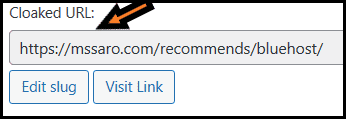
Plugins are great for helping when you have many affiliate links.
Key Points to Successfully Promote Your Affiliate Links and Boost Your Income.
1. Choose Relevant and High-Quality Affiliate Programs:
Selecting the right affiliate programs that align with your niche and target audience is crucial.
Look for programs offering high-quality products or services you genuinely believe in and can confidently promote.
Ensure the commission structures are fair and competitive to make it worth your effort.
2. Integrate Affiliate Links Seamlessly into Your Content:
Effective promotion is all about seamlessly integrating your affiliate links into your content.
Instead of bombarding your audience with links, choose strategic placements that are natural and contextually relevant.
Incorporate them organically into your blog posts, reviews, or social media captions to increase the likelihood of clicks and conversions.
3. Craft Engaging and Compelling Content:
Create content that provides value and encourages your audience to take action.
Write informative blog posts, create engaging videos, or share captivating social media posts that highlight the benefits and usefulness of the products or services you’re promoting.
The more compelling and persuasive your content is, the higher the chances of driving conversions.
4. Leverage the Power of Product Reviews:
Product reviews are a powerful tool for promoting affiliate links.
Share in-depth and honest reviews of the products or services you’re affiliated with.
Provide real-life experiences, pros and cons, and actionable insights.
Your audience will appreciate the transparency and authenticity, which will make them more likely to trust your recommendations and purchase through your affiliate link.
5. Utilize Email Marketing:
Leverage your email list to promote your affiliate links directly to engaged subscribers.
Send newsletters or dedicated emails highlighting exclusive offers, discounts, or limited-time promotions.
Personalize your emails for better conversion rates and track click-through rates to gauge the effectiveness of your campaigns.
6. Harness the Power of Social Media:
Leverage the vast reach of social media platforms to promote your affiliate links.
Create visually appealing and engaging content on Instagram, Facebook, YouTube, or other platforms.
Share tutorials, demonstration videos, or behind-the-scenes glimpses that showcase the benefits and features of the products or services you’re affiliated with.
Don’t forget to disclose your affiliate partnerships as per the Federal Trade Commission (FTC) guidelines.
7. Implement SEO Strategies:
Optimize your blog posts and content with relevant keywords to improve search engine rankings.
By targeting keywords related to the products or services you promote, you can attract organic traffic and increase the visibility of your affiliate links.
Incorporate the links naturally within relevant anchor texts to enhance user experience and SEO.
8. Track Performance and Refine Your Tactics:
Regularly monitor and analyze the performance of your affiliate links.
Leverage tools and analytics the affiliate programs provide to track clicks, conversions, and earnings.
Identify the most effective promotional strategies and optimize your efforts accordingly.
Be open to experimenting with different approaches, but remember to give each tactic enough time to generate meaningful results.
Promoting affiliate links can be a lucrative endeavor when done strategically and authentically.
By choosing relevant programs, integrating links seamlessly, creating compelling content, leveraging email marketing and social media, optimizing for SEO, and analyzing performance, you can unlock the power of affiliate marketing and boost your earnings.
Building trust with your audience is paramount, so always prioritize transparency.
Conclusion
Affiliate links are undoubtedly one of the best ways to earn money online.
You have to recommend the products you have personally used or know to your readers, and when they go with your recommendations and purchase from those links, you will get a commission out of it without any extra charge to your readers.
Remember that quality content and promoting your content on different platforms enhance your traffic and simultaneously enhance your earnings.
Points to Remember
- Must have a website, as it would be easier to promote and add affiliate links there.
- Start writing a blog on the product you want to recommend to your readers.
- Your readers have two main search intents: your website (blog post) and your YouTube channel (videos). So, write a quality blog post and make a corresponding video.
- Integrate your YouTube videos with your blog posts.
- Promote your content on social media platforms so readers are redirected to your website and can purchase from the affiliate links you have pasted in your blog post.
- Add affiliate links to the YouTube description (corresponding to the video of the recommended products)
- Affiliate links are allowed on Pinterest and LinkedIn without cloaking.
- You should cloak your affiliate link before posting it on social media platforms.
- Email marketing and blog posts are the best ways to target an audience for affiliate purchases.
- Join forums and community, and post your blogs to redirect traffic towards your website.
- Always include a disclosure/disclaimer about affiliate links.
I look forward to hearing from you. What strategy are you adopting for your affiliate link promotions? Comment us in our comment section.
Keep Smiling and Start Sharing!
Frequent-Asked Questions ( FAQ ) on How to Promote Affiliate Links
Answer: An affiliate program is provided by the brands/ companies to the affiliate partners to promote their products.
The Affiliate partners get a unique affiliate link for the product. By placing that link on their website, blog post, YouTube, or social media platforms, they recommend the product to their readers.
You can quickly get affiliate links through the company websites (in-house affiliate links) or from affiliate networks like ShareASale, Commission Junction, Impact Radius, Clickbank, etc.


